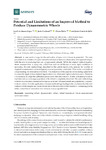Potential and Limitations of an Improved Method to Produce Dynamometric Wheels

Ver/Abrir
Use este enlace para citar
http://hdl.handle.net/2183/20789
Excepto si se señala otra cosa, la licencia del ítem se describe como http://creativecommons.org/licenses/by/3.0/es/
Colecciones
- Investigación (EPEF) [592]
Metadatos
Mostrar el registro completo del ítemTítulo
Potential and Limitations of an Improved Method to Produce Dynamometric WheelsFecha
2018Resumen
[Abstract:] A new methodology for the estimation of tyre-contact forces is presented. The new
procedure is an evolution of a previous method based on harmonic elimination techniques developed
with the aim of producing low cost dynamometric wheels. While the original method required
stress measurement in many rim radial lines and the fulfillment of some rigid conditions of
symmetry, the new methodology described in this article significantly reduces the number of
required measurement points and greatly relaxes symmetry constraints. This can be done without
compromising the estimation error level. The reduction of the number of measuring radial lines
increases the ripple of demodulated signals due to non-eliminated higher order harmonics. Therefore,
it is necessary to adapt the calibration procedure to this new scenario. A new calibration procedure
that takes into account angular position of the wheel is completely described. This new methodology
is tested on a standard commercial five-spoke car wheel. Obtained results are qualitatively compared
to those derived from the application of former methodology leading to the conclusion that the new
method is both simpler and more robust due to the reduction in the number of measuring points,
while contact forces’ estimation error remains at an acceptable level.
Palabras clave
Measuring wheel
Dynamometric wheel
Wheel transducer
Forces measurement
Dynamometric wheel
Wheel transducer
Forces measurement
Versión del editor
ISSN
1424-8220






